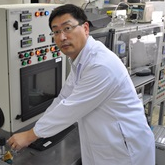Application of Nanotechnology in Environmental Remediation
A special issue of Applied Sciences (ISSN 2076-3417). This special issue belongs to the section "Environmental Sciences".
Deadline for manuscript submissions: closed (20 November 2023) | Viewed by 229
Special Issue Editors
Interests: water treatment; nanomaterials; environmental chemistry; materials chemistry; nanostructured materials; adsorption; nanotechnology; chemical engineering; catalyst; photocatalysis
Interests: water treatment; MOFs; nanomaterials; environmental chemistry; materials chemistry; nanostructured materials; adsorption; nanotechnology; environmental engineering; environmental material
Special Issue Information
Dear Colleagues,
With the development of the economy and industrialization, environmental pollution is becoming more serious, which has attached world concern and affects human health. Nanotechnology can remediate contaminated environments effectively through the manipulation and manufacture of materials and devices on the scale of atoms or small groups of atoms.
Nanotechnology for environmental remediation maintains a rapid development speed. New and effective nanomaterials are emerging, and many are being successfully applied in practice. Since they have a high specific surface area and porosity, they are effective for removing heavy metals, dyes, volatile organic compounds, and so on from the environment.
This Special Issue intends to present various nanomaterials for the remediation of different environmental contaminants and their remediation process.
Dr. Darren Sun
Dr. Jia-Cheng E. Yang
Guest Editors
Manuscript Submission Information
Manuscripts should be submitted online at www.mdpi.com by registering and logging in to this website. Once you are registered, click here to go to the submission form. Manuscripts can be submitted until the deadline. All submissions that pass pre-check are peer-reviewed. Accepted papers will be published continuously in the journal (as soon as accepted) and will be listed together on the special issue website. Research articles, review articles as well as short communications are invited. For planned papers, a title and short abstract (about 100 words) can be sent to the Editorial Office for announcement on this website.
Submitted manuscripts should not have been published previously, nor be under consideration for publication elsewhere (except conference proceedings papers). All manuscripts are thoroughly refereed through a single-blind peer-review process. A guide for authors and other relevant information for submission of manuscripts is available on the Instructions for Authors page. Applied Sciences is an international peer-reviewed open access semimonthly journal published by MDPI.
Please visit the Instructions for Authors page before submitting a manuscript. The Article Processing Charge (APC) for publication in this open access journal is 2400 CHF (Swiss Francs). Submitted papers should be well formatted and use good English. Authors may use MDPI's English editing service prior to publication or during author revisions.
Keywords
- nanotechnology
- nanomaterials
- nanostructures
- nanofibers
- nanotube
- nanoparticles
- environmental remediation
- water treatment
- photocatalysis






